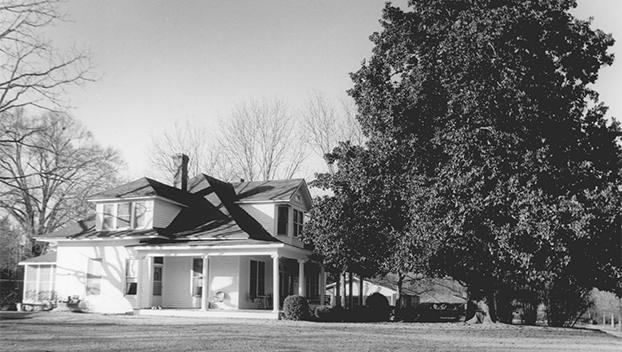Mississippi teacher restores historic house built in 1914
Published 5:39 am Saturday, June 4, 2022
About eight years ago, Kellie Dillard became interested in buying an old home in Saltillo known as the Barlow Burrow House, which had been unoccupied for several years.
The two-story Colonial Revival residence was built by Saltillo merchant Barlow Burrow in 1914. It sits on the same site as the home of his father, Capt. John H. Burrow, which was built in the 1870s.
In the fall of 2020, the home’s owners, Judd and Donna Hambrick, who purchased the house and its contents from the Burrow family in 1983, agreed to sell it to Dillard.
She immediately began work to bring it back to its former glory.
“A lot of what we put into it, you can’t see – all new duct work, new plumbing, new electrical, insulation, new central heat and air units,” said Dillard, who teaches 10th grade English at Saltillo High School.
The first thing Dillard did was put a new roof on the home. She also had foundation work done to make the house sit level again.
“What’s neat is there was no termite damage – none,” she said.
Because no one had been living in the home for a while, the landscaping had gotten out of control.
“You couldn’t see the house for the shrubbery and bushes that had been there for 60 or 70 years,” Dillard said. “We had to have a lot of that taken out. Locals would camp out to see all the work being done. My favorite thing about living here is all the stories people have told me about the house.”
All the walls and ceilings were covered in bead board, which Dillard kept on the ceilings and inner walls. She had Sheetrock put on the outer rooms of the house for heating and cooling purposes.
Dillard had the home’s interior walls painted a soft cream color, and all the woodwork was cleaned and stained to its original dark-brown color. She also added new light fixtures to several areas in the house.
“All the hardwood floors are original to the home,” Dillard said. “Most of the floors were covered by carpet or area rugs, so they were in excellent condition. Only the floor in the kitchen and butler’s pantry had to be tiled. The hardwood couldn’t be salvaged because some of it had buckled and other parts were covered in layers of linoleum.”
There are six non-functional coal-burning fireplaces in the home, and the mantels on the two fireplaces upstairs are original to the home that was built on the property in the 1870s.
The home’s front entrance consists of a single beveled glass door surrounded by sidelights of single panels of beveled glass. The fixed transom features three windows. Except for one 18-pane window in the living room, most of the windows in the house are large double-hung sash units.
“This house was untouched,” Dillard said. “Even the wavy glass in the windows is original.”
The downstairs encompasses a reception hall, living room, dining room, kitchen and butler’s pantry, a half-bath, and a master suite with a sitting area and bath. Upstairs there are three bedrooms and one bath.
There are two staircases leading to the second floor: The main staircase in the reception hall has two bottom steps curving around a newel post; the back staircase is off the kitchen.
A few pieces of antique furniture, like the dining room table, were in the home when Dillard purchased it, but the rest she has collected over the past 30 years.
“Nothing in this house matches,” she said. “There’s Empire, Duncan Phyfe, Federal styles. The grandfather clock in the dining room was built the same year as this house – 1914. There’s nothing new in this house except the living room furniture.”
One of the most striking aspects of the home is the eclectic collection of artwork on the walls.
“We love tag sales, estate sales, junk sales, antiques shops,” Dillard said. “There’s an 1852 painting of a gentleman that hangs over the fireplace in the dining room that I got at a tag sale. I have no idea who he is. We named him Uncle Cyrus.”
Dillard’s mother lived in Ocean Springs for several years, and that’s where Dillard fell in love with the artwork of Walter Anderson.
“I probably have a dozen or more of his pieces,” she said. “I’ve been collecting artwork for 20 years. I just buy what I like – this house is a hodgepodge of what I like. I’m not trying to look like something in a magazine.”
The outside of the home also got a transformation. Dillard had French drains installed along with an irrigation system, lighting, brick steps and walkways, and new landscape plants.
“There are two Magnolia trees out front that we kept, but had trimmed up,” she said. “That’s my favorite part about the outside of the house. I love the fact that they shade the house, but also that they’re that old.”
Work on the home was completed last November, and that’s when Dillard and her daughter, Mary Kirk, were able to move into the house. Mary Kirk is a student at Mississippi State University, majoring in architecture. Dillard’s son, Bradley, and his wife, Laiken, live in Tupelo.
In 1983, the previous owners and others had the Barlow Burrow House placed on the National Register of Historic Places because of its architectural and historical significance.
That’s one reason Dillard wanted the home – not just for herself, but for her daughter.
“I want to get my certificate in historical preservation,” Mary Kirk said. “This is the kind of work I want to do – get into older homes and promote sustainability.”
Dillard said there are a lot of cool old houses in Saltillo, and she hopes more young families will buy them and restore them.
“I hoped in redoing this property that there would be a trickle-down effect,” Dillard said. “I’m glad we were able to bring this old house back. I feel like I’m a caretaker of history.”





